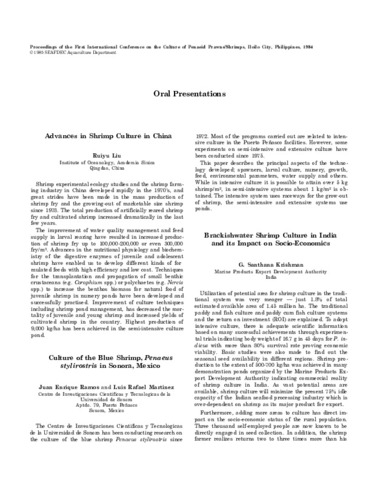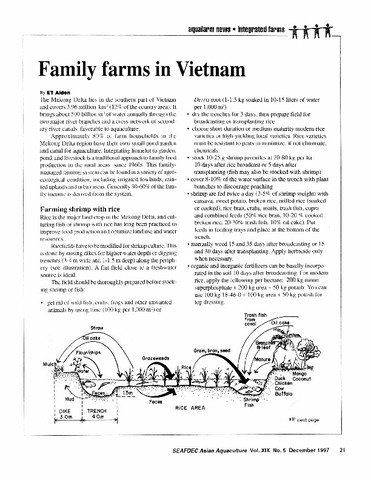Brackishwater shrimp culture in India and its impact on socio-economics
- Global styles
- MLA
- Vancouver
- Elsevier - Harvard
- APA
- Help
Share
Abstract
Utilization of potential area for shrimp culture in the traditional system was very meager — just 1.8% of total estimated available area of 1.45 million ha. The traditional paddy and fish culture and paddy cum fish culture systems and the return on investment (ROI) are explained. To adopt intensive culture, there is adequate scientific information based on many successful achievements throughexperimental trials indicating body weight of 16.7 g in 45 days for P. indicus with more than 80% survival rate proving economic viability. Basic studies were also made to find out the seasonal seed availability in different regions. Shrimp production to the extent of 500-700 kg/ha was achieved in many demonstration ponds organized by the Marine Products Export Development Authority indicating commercial reality of shrimp culture in India. As vast potential areas are available, shrimp culture will minimize the present 75% idle capacity of the Indian seafood processing industry which is over-dependent on shrimp as its major product for export.
Furthermore, adding more areas to culture has direct impact on the socio-economic status of the rural population. Three thousand self-employed people are now known to be directly engaged in seed collection. In addition, the shrimp farmer realizes returns two to three times more than his counterpart in paddy cultivation, in the same field and for more or less the same period of time. In West Bengal, of total export value of 43 crores, up to 25 crores is realized by farmers for their production of shrimp through culture reflecting better unit return for their raw material than that realized byprocessor/exporter of the end-product. Therefore, bringing additional areas under shrimp culture will directly affect the socio-economic status of the rural people employing an average of 5 persons/ha, and indirectly affect no less than 15,000 casual workers in the seafood processing industry by additional utilization of manpower and working hours.
As productivity from capture appears bleak, brackish-water shrimp culture has been accorded top priority in India's national developmental programmes for more harvest from aquatic sources otherwise termed the "Blue Revolution."
Description
Abstract only.
Suggested Citation
Krishman, S. G. (1985). Brackishwater shrimp culture in India and its impact on socio-economics (Abstract only). In Taki Y., Primavera J.H. and Llobrera J.A. (Eds.). Proceedings of the First International Conference on the Culture of Penaeid Prawns/Shrimps, 4-7 December 1984, Iloilo City, Philippines (pp. 163-164). Iloilo City, Philippines: Aquaculture Department, Southeast Asian Fisheries Development Center.
Type
Oral presentationISBN
9718511008
Related items
Showing items related by title, author, creator and subject.
-
The Philippine aquaculture industry
Camacho, Arsenio S.; Macalincag-Lagua, Natividad (Aquaculture Department, Southeast Asian Fisheries Development Center, 1988)The aquaculture sector of the Philippine fishing industry registered the highest growth rate of 12.5% in 1977-1986. The contribution of aquaculture to the total fish production was equivalent to 24% in 1986 compared to ... -
Family farms in Vietnam
Aldon, Eva T. (Aquaculture Department, Southeast Asian Fisheries Development Center, 1997) -
Nursery and grow-out operation and management of Penaeus monodon (Fabricius)
Corre, Kaylin G. (Aquaculture Department, Southeast Asian Fisheries Development Center, 1988)The results of research on nursery and grow-out rearing of prawn conducted by the SEAFDEC Aquaculture Department for over a decade are reviewed. Different rearing facilities designed to accommodate hatchery-produced prawn ...






